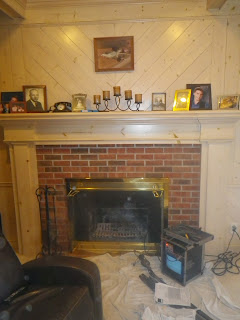Get the fireplace ready for Fall and Winter
Cool Fall weather approaches, and soon
a cozy fire in the fireplace will be enjoyed by many. Fireplaces
need annual maintenance, and while Spring is the best time for
sweeping chimneys to remove smelly creosote, most homeowners wait
until cool weather hits to have the chimney inspected. Chimney
sweeps call Fall the “insane season” for this reason.
The National Fire Protection Association recommends annual inspection by a professional chimney
sweep and sweeping as necessary to remove flammable creosote.
Creosote is the natural by-product of combustion and occurs even when
dry hardwoods are used. It needs to be removed on a regular basis in
order to avoid chimney fires, which can cause thousands of dollars in
damages.
A chimney sweep should do a visual and
internal camera inspection of the flue and smoke chamber, and all
components of the fireplace and chimney, and provide a written report
of his/her findings. If repair is necessary, the sweep should
explain the problem and offer repair solutions. If he does not do
repair work he should refer the homeowner to a qualified chimney
contractor.
 Many chimneys have
been affected by the summer drought conditions. Dry ground retracts
from chimney footings, and can cause the structure to lean. If a
chimney leans far enough, the only solution is to have it torn down
and rebuilt. This should be checked by a specialty chimney
contractor, rather than a chimney sweep who only sweeps chimneys.
Many chimneys have
been affected by the summer drought conditions. Dry ground retracts
from chimney footings, and can cause the structure to lean. If a
chimney leans far enough, the only solution is to have it torn down
and rebuilt. This should be checked by a specialty chimney
contractor, rather than a chimney sweep who only sweeps chimneys.
Wood stoves should be swept and
inspected at least twice during the burning season. Creosote
accumulates on the interior of small chimney pipe and can cause
drafting and performance problems.
If sudden smoking occurs while burning
a fire, this can be a sign that a chimney fire has occurred. During
a chimney fire, creosote expands outward and may cut off draft, which
can cause smoking. If a chimney fire is suspected, the homeowner
should call a professional CSIA Certified Chimney Sweep to inspect it
before using the fireplace or wood stove again.
Check list for Fall fireplace
preparation:
- Be sure that glass doors or a screen is installed to keep sparks at bay. Rusted screens can be replaced. A good set of glass doors with a seal help to keep cold drafts out of the house when the fireplace is not in use.
- A top-sealing damper provides better protection from drafts and keeps insects and bats out of the flue since it creates an almost air-tight seal at the top of the flue.
- Be sure to have a good quality heavy duty stainless steel chimney cover installed on all flues to keep damaging birds, animals, and rain out of the flues.
- Obtain a good set of fireplace tools that will last for years.
- Keep combustible materials and wood at least 36” away from the fireplace opening.
- Have the chimney and fireplace inspected and swept by a professional chimney sweep. If in doubt, don't use the fireplace until it is inspected. Make sure the sweep uses an internal camera system for the inspection. He/she will advise you whether the chimney is in suitable working condition or not.
- Have masonry repairs made before cold weather sets in. Cracks or missing mortar joints on exterior chimneys or in cement crowns allow damaging rain to enter the interior chimney.
- If the flue, smoke chamber, or fireplace is damaged and needs to be relined, do not use it until this work is completed.####Marge Padgitt is the author of the Chimney and Hearth Pro's Resource Book. She is a CSIA Certified Chimney Sweep and NFI Woodburning Specialist. Padgitt is the president of HearthMasters, Inc. in Independence, Missouri, which has been in business since 1982. Marge travels the country to lecture at seminars and meetings. Contact her at margepadgitt@comcast.net or 816-461-3665.

No comments:
Post a Comment
Note: Only a member of this blog may post a comment.